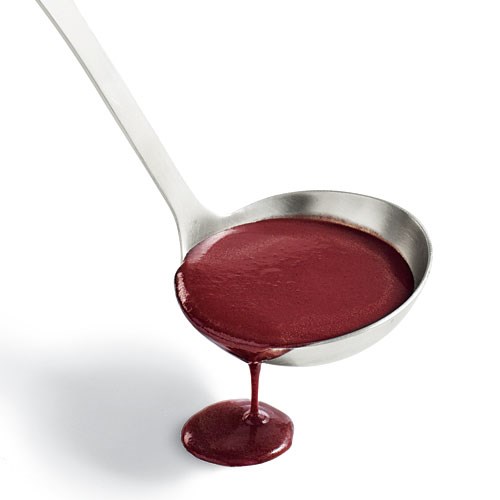Reduction is the process of thickening a watery liquid using heat: don't miss these tips and cooking techniques.
Sauces
are one of the most mysterious aspects of cooking. Fundamentally, they are
believed to be simple preparations but, when we actually taste a good sauce, we
find it difficult to reproduce. This mainly happens because few people know how
to go about making a proper reduction.
What does reduction
mean?
Reduction
is in fact the process of thickening a watery liquid using heat. On one hand,
the existing water evaporates and, as a result, the liquid becomes denser and,
on the other hand, there are compounds which, when heated, tend to solidify.
The basic concept, however, is always the same: we have some pan juices, maybe
those of roast veal (can you imagine a more mouth-watering flavour?), and we
have to make them into a sauce or gravy. How should we go about it?

Red Wine Reduction.
How to make a
delicious sauce using reduction?
Cooking
is the first step: remove the cooked meat and place the pan on a high flame. As
soon as the liquid starts to bubble, it has to be stirred constantly with a
wooden spoon. The principle is simple: the water will evaporate, concentrating
the existing fats and proteins to create a delicious sauce. A dash of alcohol
during the cooking process, whether wine or a dry liquor, adds the aromatic
residue that "sticks" to the bottom of the pan. This method is
generally more than effective for most purposes, but is frowned upon in the
most prestigious kitchens owing to a subtle, yet significant, defect: the heat
tends to undermine the original aromas. Aroma and flavour, in brief, are spoilt
by being further subjected to a high temperature. Hence the reasoning behind
the use of cryo-concentration.
This
cooking technique is based on the fact that water freezes at 0°C. So, by taking
liquids with which water does not mix well – such as pan juices rich in fats
(fats and water tend to remain separated) to 0°C, only the water will freeze
and turn into ice crystals.
Once
these are removed, the water is eliminated without any need for heat. As a
result, the liquid is "reduced" leaving all of its aromas intact. In
actual fact, in the case of cryo-concentration, the temperature must be some
degrees lower than zero because if the liquid is not composed of water alone,
the freezing point will be lower. This aspect, however, is taken care of by the
Freeze Dryer, a special machine (costing about $3000) which will vacuum pack the
liquid once it is frozen in a special bag. The final product is, to all effects
and purposes, a reduction, but in a solid form and ready to be used for making
a delicious sauce, possibly with the addition of melted butter.
How to make brown
(and dark) roux?
Finally,
we may decide to go for a “roux,” a more traditional method. As we learnt
speaking about the so-called mother sauces of French cuisine, it's the base of
bechamel and involves melting butter and adding a sprinkling of flour gradually,
while mixing constantly and patiently.
After
four to five minutes, a thick mixture is created with a neutral flavour, for
adding to a liquid to turn into a sauce. If we extend the cooking time to seven
to eight minutes, the “roux” will change colour (owing to the Maillard reaction
between the sugar and proteins contained in the flour). What you have now is a
“brown roux,” which has a more pronounced flavour, but tends to thicken less.
If
it is cooked up to 15 minutes the mixture will become very dark, in fact it is
now called a “Dark Roux”: it has a very pronounced caramelised flavour, but not
much thickening power. According to the liquid you wish to thicken and bearing
in mind its consistency and flavour, you may combine it with the most suitable
roux to produce a hot sauce ready to accompany meat or even a simple slice of
toasted bread.
Go
on, let your imagination run wild with your cooking pan juices.
By FDL